
La Earthcache / The Earthcache
L'aménagement de l'ancienne carrière de la Miseri en Jardin Extraordinaire fait la part belle aux roches de l'ouest nantais, permettant la découverte de quelques particularités locales.
► Contexte géologique local
L'ancienne carrière de la Miseri prend place au pied de la butte Saint Anne, au cœur du massif plutonique d'Orvault-Mortagne, un granite orienté à deux micas.
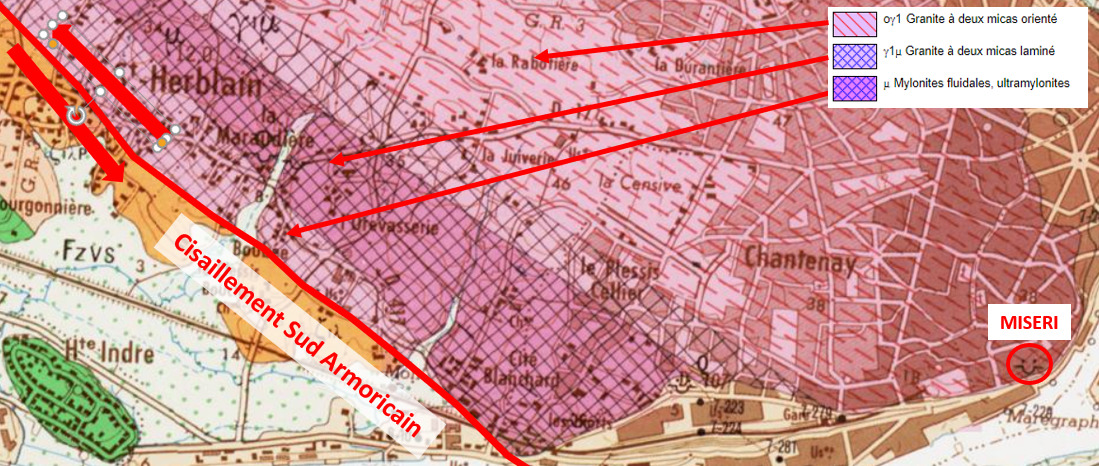
Né grâce au Cisaillement Sud-Armoricain, il s'est aussi transformé à cause de lui.
► Le granite orienté à deux micas de la Miséri
Il y a 310 millions d'années (orogenèse hercynienne), un batholite de leucogranite s'est inséré dans le socle métamorphique à la faveur d'un accident tectonique, le « Cisaillement Sud-Armoricain ».
~ Une roche QFM
Ce granite est une roche à cristaux submillimétriques principalement composés de :
- Q comme Quartz : minéral gris sans facette translucide parfois transparent.
- F comme Feldspath : principalement de l'albite, un feldspath plagioclase sodique blanc opaque.
- M comme Mica : fines paillettes brillantes blanches (muscovite) ou noires (biotite).

Il est non orientée et présente une teinte claire (leucocrate) car il est pauvre en biotite, un minéral ferromagnésien.
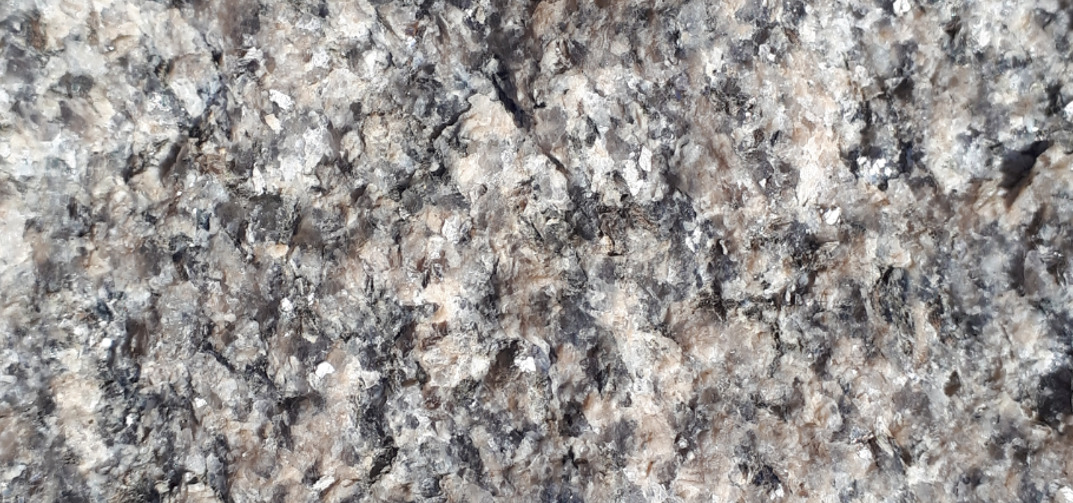
Ce granite a quelques particularités observables au Jardin Extraordinaire.
~ Une richesse en minéraux accessoires
Ce granite se différencie par sa richesse en minéraux accessoires colorés.
Ils sont surtout présents dans des filons de pegmatites issus de la lente cristallisation d'un jus résiduel ayant donné de gros cristaux.
On y trouve par exemple de la tourmaline, du grenat almandin, du béryl et de la galène.

~ La présence de Xénolithes, inclusions sombres basiques
Le magma granitique est acide (riche en minéraux siliceux - quartz et feldspath) mais contient des enclaves magmatiques plus basiques (riches en ferromagnésiens comme la biotite).
Les magmas acides et basiques étant non miscibles, ils vont cristalliser sans se mélanger, aboutissant à des xénolithes, enclaves basiques sombres au sein d'un encaissant acide clair.

~ La Rubéfaction, coloration de la roche cristalline
Mis au contact de l'air, ce granite va se colorer en rouge/rose lors de la dégradation de minéraux roches en fer comme la biotite, libérant du fer qui sous la forme d'oxydes ferriques.
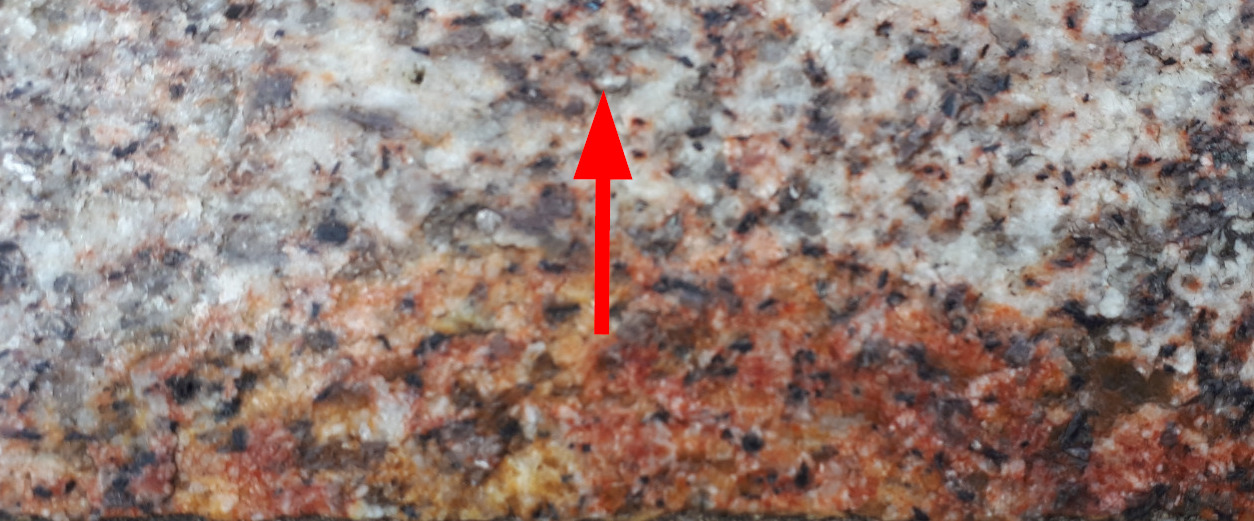
► le C.S.A : du granite à la mylonite
Le batholite d'Orvault-Mortagne est au contact sur son flanc ouest avec le C.S.A (Cisaillement Sud-Armoricain), surnommé la « Zone broyée armoricaine».
Cet élément tectonique armoricain majeur a permis la naissance du batholite, mais a aussi profondément transformé sa partie en contact avec lui.
Au fur et à mesure qu'on s'approche de la faille, les pressions exercées et les mouvements de déplacement ont compressé et transformé le granite en mylonite.
Un double phénomène affecte les cristaux de quartz :
- Un écrasement et un allongement des cristaux.
- Une orientation en bandes fluidales, donnant une linéation (structure orientée de la roche) suivant la direction structurale du C.S.A. (N 120°).
Les feldspaths résistent à la cataclase au début, puis s'arrondissent ou s'étirent.
Les rares biotites disparaissent rapidement et les micas blancs se retrouvent en petits débris.
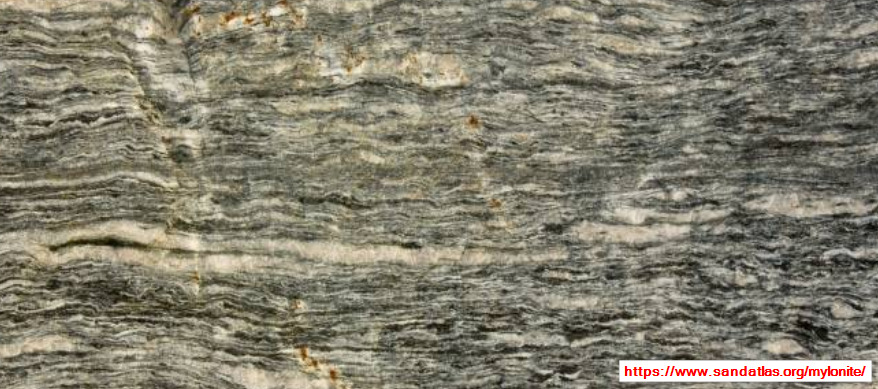
The development of the old Miseri quarry into an Extraordinary Garden gives pride of place to the rocks of the west of Nantes, allowing the discovery of some local peculiarities.
► Local geological context
The old Miseri quarry takes place at the foot of the Butte Saint Anne, in the heart of the Orvault-Mortagne plutonic massif, a two-mica oriented granite.
Born thanks to the South Armorican Shear, he was also transformed because of him.
► The two-mica oriented granite of La Miséri
310 million years ago (Hercynian orogeny), a leucogranite batholith was inserted into the metamorphic basement due to a tectonic accident, the “South Armorican Shear”.
~ A QFM rock
This granite is an undirected rock with submillimeter crystals mainly composed of:
- Q for Quartz: gray mineral without translucent facet sometimes transparent.
- F for Feldspar: mainly albite, an opaque white sodium plagioclase feldspar.
- M for Mica: fine shiny white (muscovite) or black (biotite) flakes.
It has a light shade (leucocratic) because it is poor in biotite, a ferromagnesian mineral.
This granite has some peculiarities observable in the Extraordinary Garden.
~ A wealth of accessory minerals
This granite is distinguished by its richness in colored accessory minerals.
They are mainly present in pegmatite veins resulting from the slow crystallization of a residual juice which has given large crystals.
There are, for example, tourmaline, almandine garnet, beryl and galena.
~ The presence of Xenoliths, basic dark inclusions
Granitic magma is acidic (rich in siliceous minerals - quartz and feldspar) but contains more basic magmatic enclaves (rich in ferromagnesium such as biotite).
The acidic and basic magmas being immiscible, they will crystallize without mixing, resulting in xenolites, dark basic enclaves within a clear acidic host.
~ Rubifaction, coloring of crystalline rock
When placed in contact with air, this granite will turn red / pink during the degradation of iron rock minerals such as biotite, releasing iron which in the form of ferric oxides.
► C.S.A: from granite to mylonite
The Orvault-Mortagne batholith is in contact on its western flank with the C.S.A (South Armorican Shear), nicknamed the “Armorican crushed zone”.
This major Armorican tectonic element allowed the birth of the batholith, but also profoundly transformed its part in contact with it.
As we approached the fault, the pressures exerted and the displacement movements compressed and transformed the granite into mylonite.
A double phenomenon affects quartz crystals:
- Crushing and elongation of crystals.
- An orientation in fluid bands, giving a lineation (oriented structure of the rock) following the structural direction of the C.S.A. (N 120 °).
Feldspars resist cataclase at first, then round or stretch.
The rare biotites disappear quickly and the white micas are found in small debris.
► Sources bibliographiques / Bibliographical sources
Les Questions / The Questions
La lecture attentive du descriptif de la cache, ainsi qu'une observation des éléments de terrain et un peu de déduction sont normalement suffisants pour répondre aux questions de cette EarthCache.
A careful reading of the description of the cache, as well as observation of terrain features and some deduction is usually sufficient to answer questions of this EarthCache.
Questions pour valider :"Curiosités géologiques au Jardin Extraordinaire"
Questions to validate: "Geological curiosities at the Extraordinary Garden"
Accès soumis à horaires d'ouverture, consulter le site des Jardins de Nantes.
Access subject to opening hours, consult the website Gardens of Nantes.
Point 1 : N 47° 12.011 W 001° 34.885
- Question 0 : Prenez une photo de vous ou d'un élément vous identifiant depuis le pont en métal avec la cascade en arrière plan. Peut être verrez-vous un arc en ciel !
Cette photo devra au choix nous être transmise avec les réponses ou être ajoutée à votre log.
- Question 0 : Take a photo of yourself or something that identifies you from the metal bridge with the waterfall in the background. Maybe you will see a rainbow!
This photo must either be sent to us with the answers or added to your log.
Depuis le bout du pont en direction de la cascade, repérez au premier plan les rochers au bord de l'eau, dont un avec un filon de pegmatite (zone rouge de la photo WP1). Allez l'observer.
From the end of the bridge towards the waterfall, spot the rocks at the water's edge in the foreground, including one with a pegmatite vein (red area of photo WP1). Go watch it.

- Question 1 : Décrivez les phénocristaux d'un minéral accessoire coloré que vous pouvez observer dans cette veine et déduisez en la nature de ce minéral accessoire.
- Question 1 : Describe the phenocrysts of a colored accessory mineral that you can observe in this vein and infer the nature of this accessory mineral.
!! Les questions 2 à 5 ci-dessous sont à utiliser pour les WP2 et WP3 !! Suivez les instruction des WPs pour savoir lesquelles choisir.
!! Questions 2 to 5 below are to be used for WP2 and WP3 !! Follow the instructions of the WPs to know which ones to choose.
- Question 2 : Quelle est la couleur générale du dessus de la roche et à quoi est-elle due ?
- Question 2 : What is the general color of the top of the rock and what is it due to?
- Question 3 : Vous remarquez une inclusion de couleur différente dans cette zone. De quel minéral est-elle principalement formé et comme appelle t-on ce type de formation ?
- Question 3 : You notice a different colored inclusion in this area. What mineral is it mainly formed from and what is this type of formation called?
- Question 4 : Quelle caractéristique principale différencie cette roche du granite de la Miséri ? Observez de près les cristaux de quartz (forme, disposition) pour expliquer cette caractéristique.
- Question 4 : What main characteristic differentiates this rock from the granite of La Miséri? Observe quartz crystals closely (shape, arrangement) to explain this characteristic.
- Question 5 : Comment appelle t-on cette roche et à cause de quoi s'est-elle mise en place ?
- Question 5 : What is this rock called and what did it fall into place?
Point 2 : N 47° 12.010 W 001° 34.877
Revenez sur le chemin puis dos à la cascade, quittez le sur quelques mètres en restant bien sur les rochers. Observez la partie supérieure du bloc sous la zone jaune (photo WP2).
Come back on the path then with your back to the waterfall, leave it for a few meters while staying on the rocks. Observe the upper part of the block under the yellow area (photo WP2).
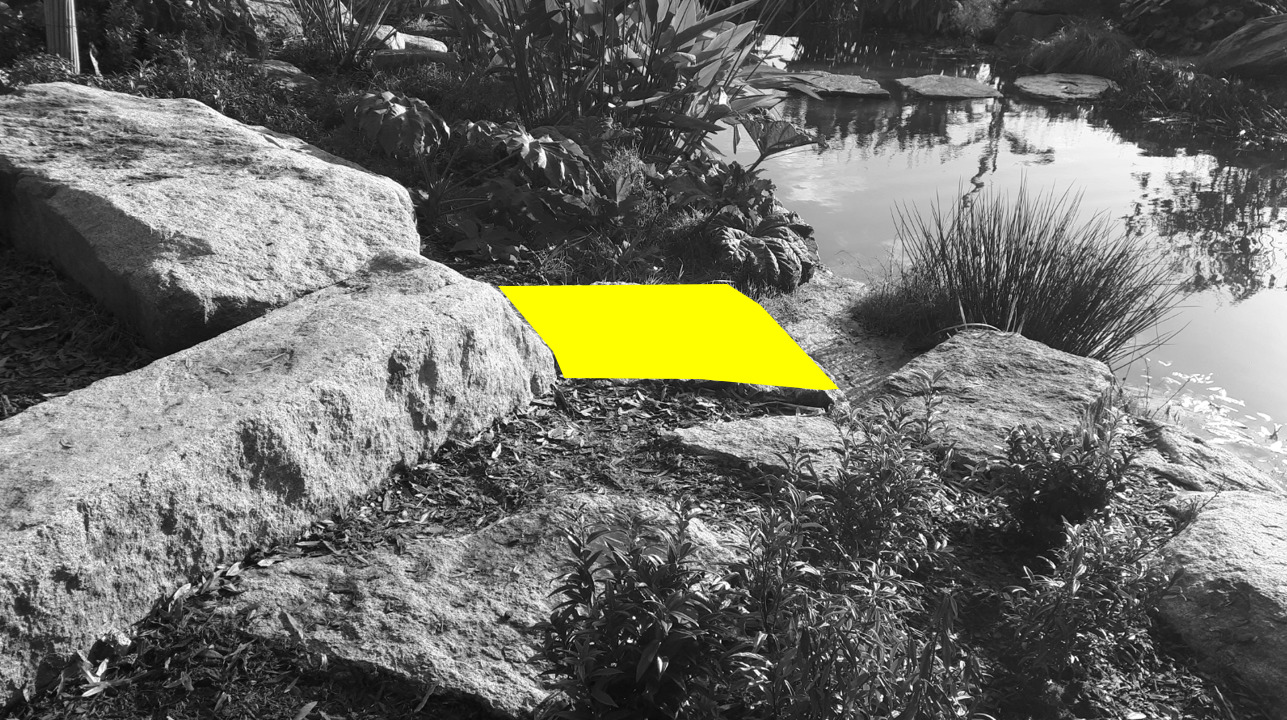
En observant les caractéristiques de ce bloc, pensez-vous qu'il vient de la carrière ?
Si la réponse est Oui : répondez aux questions 2 et 3 décrites ci-dessus.
Si la réponse est Non : répondez aux questions 4 et 5 décrites ci-dessus.
Looking at the characteristics of this block, do you think it comes from the quarry?
If the answer is Yes : answer questions 2 and 3 described above.
If the answer is No : answer questions 4 and 5 described above.
Point 3 : N 47° 12.002 W 001° 34.813
Face à l'entrée, observez la partie supérieure du bloc sous la zone bleue (photo WP3).
> Facing the entrance, observe the upper part of the boulder under the blue zone (photo WP3).

En observant les caractéristiques de ce bloc, pensez-vous qu'il vient de la carrière ?
Si la réponse est Oui : répondez aux questions 2 et 3 décrites ci-dessus.
Si la réponse est Non : répondez aux questions 4 et 5 décrites ci-dessus.
Looking at the characteristics of this block, do you think it comes from the quarry?
If the answer is Yes : answer questions 2 and 3 described above.
If the answer is No : answer questions 4 and 5 described above.
Vous pouvez vous loguer sans attendre notre confirmation,
mais vous devez nous envoyer les réponses en même temps soit par mail via notre profil (
fafahakkai), soit via la messagerie geocaching.com (Message Center).
S'il y a des problèmes avec vos réponses nous vous en ferons part.
Les logs enregistrés sans réponses seront supprimés.
You can log this cache without waiting for our confirmation, but you must send us the answers at the same time, by e-mail via our profile (fafahakkai) or by the system of Message Center of geocaching.com.
If there is a problem with your answers we will notify you. The logs recorded without answers will be deleted.
Rappel concernant les « Earthcaches »: Il n'y a pas de conteneur à rechercher ni de logbook à renseigner. Il suffit de se rendre sur les lieux, de répondre aux questions ci-dessus et de nous renvoyer les réponses.
Reminder concerning "Earthcaches": there is neither a container to look for nor a logbook to sign. One need only go to the location, answer to the differents questions and send us the answers.